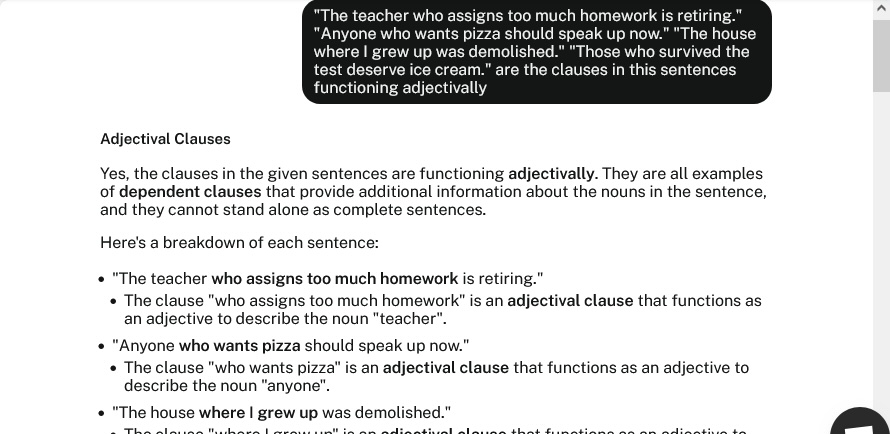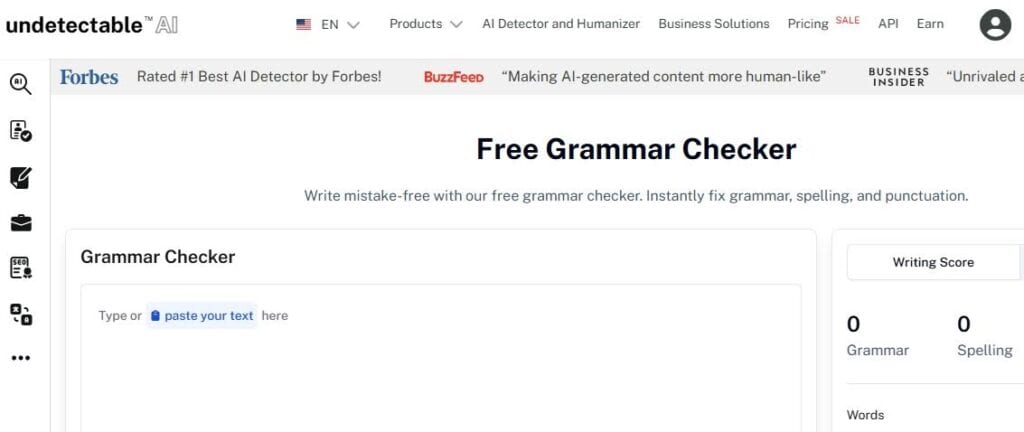Have you ever read a sentence and thought to yourself, “How does this sentence have a lot of information without being bulky?”
Well, that is the work of an adjective clause. Adjective Clauses are more common than you think. The best part is, most people don’t even know that they are using them.
They can be found in your novel and even in the text you send. These small details help you combine ideas and add vital information without creating run-on sentences.
With adjective clauses, you can improve your writing without trying too hard.
Key Takeaways
- An adjective clause gives more information about a noun or pronoun
- It contains a subject and a verb
- It begins with words like which, who, or that
- An adjective clause is a dependent clause.
What Is an Adjective Clause?
Before we move to an adjective clause definition, let us see what a clause is. A clause is a set of words that has both a subject and a verb.
Now, what is an adjective clause?
An adjective clause refers to a collection of words that have a subject and a verb and provide more details about a noun or a pronoun.


Never Worry About AI Detecting Your Texts Again. Undetectable AI Can Help You:
- Make your AI assisted writing appear human-like.
- Bypass all major AI detection tools with just one click.
- Use AI safely and confidently in school and work.
An adjective clause is what you can call an ambitious adjective that chooses to become a complete sentence.
It is a dependent clause that provides more information about a noun or pronoun in your sentence.
Adjective clauses are easy to identify because they begin with a relative pronoun.
For example:
- The girl who was the spelling bee winner is my cousin.
The clause “who was the spelling bee winner” gives more information to your listener about the girl.
Here is another example:
Simple adjective: The broken laptop won’t start.
Adjective clause: The laptop that I dropped yesterday won’t start.
Both clauses refer to the laptop, but the adjective clause presents a complete account as to what occurred.
What They Modify (Nouns and Pronouns)
Relative clauses are also called adjective clauses.
They modify pronouns and nouns. Relative clauses have a subject and a verb, while adjectives are single words.
You can say they cling to any noun or pronoun they find.
Here are some adjective clause examples modifying nouns and pronouns:
- The teacher who assigns too much homework is retiring.
- Those who survived the test deserve ice cream.
In case you are not sure if a clause is functioning as an adjective, you can always use the Undetectable AI Chat to figure it out.
All you need to do is input your sentence and simply ask our AI to analyze it.

Key Components of an Adjective Clause
Apart from having a subject and a verb, an adjective clause also has some important components. The major elements of an
Adjective Clause are the following:
Relative Pronouns That Introduce the Clause
When you see a relative pronoun, there is a possibility that the sentence has an adjectival clause.
Relative clauses can also be called adjective clauses since they begin with the relative pronouns.
Examples of relative pronouns are who, whom, whose, which, and that.
- Who: This refers to persons. It also refers to people as the subject of a clause. For example, “The student who sits behind me snores during lectures.”
- Whom: This is used for people who have had things done to them. For instance, “The author whom critics praised won the award.”
- Whose: This pronoun shows possession. It shows who has what. E.g., “The neighbor whose dog barks is moving away.”
- Which: This is used to describe things and animals. E.g., “The car which broke down yesterday is finally fixed.”
- That: This is a universal donor. That is, it works for people, things, and animals. It also gives essential information about things. For example, “The movie that we watched last night was terrible.”
Position in The Sentence
You don’t have to look too far to find a relative clause. You will always find them right after the noun or pronoun that it is modifying. Here is a quick example:
- Correct: “The pizza that we ordered arrived cold.”
- Incorrect: “That we ordered, the pizza arrived cold.”
The clause “that we ordered” modifies “pizza.”
The adjectival clauses are used after the noun, unlike adjectives, which are used before the noun. It helps modify the noun or pronoun.
The implication of having a relative clause after a noun is that you can never start a sentence with it.
Necessary vs. Nonessential Clauses
Adjective clauses are either necessary or nonessential. This is usually based on the role they play in a sentence.
Some adjective clauses make a sentence better, but you can do without them.
While some are very important, and without them, the sentence is just basic.
Those clauses that give valuable information about the noun are called necessary clauses.
These clauses are so important and they cannot be removed without making the sentence unclear.
Commas are not necessary with these clauses. They are also known as restrictive clauses.
Here is an example:
- Those students who worked hard passed the exam.
You do not have to use a comma in this sentence since you have to specify the precise students who succeeded in the exam.
Nonessential Clauses, however, may be deleted in a sentence without making any difference.
They provide additional, but unnecessary details. They are also called nonrestrictive clauses, and they have to be set off by commas.
For example:
- My laptop, which cost me a fortune, just crashed.
“which cost me a fortune” is extra information, and if removed, the listener or reader knows who the laptop belongs to.
To ensure that you do not miss the comma in nonessential clauses, you can always use Undetectable AI Grammar Checker.
Our tool helps you to get your comma placement right. It will also help you flag down commas in necessary clauses and explain why the punctuation is not needed.

Adjective Clause vs Adjective Phrase
Adjective clauses and phrases both modify nouns and pronouns.
There are, however, differences between the two. It is also easy to confuse one with the other.
Structural Differences
An adjective clause has a subject and a verb combination. An adjective phrase doesn’t have a subject and a verb. It is just a bunch of words.
Here is an example of an adjective clause:
- The book that I am reading is fascinating. (Subject: I, Verb: am reading)
Here is an example of an adjective phrase
- The book on the table is fascinating. No subject, no verb.
When to Use One Over the Other
You use adjective clauses when you want to give more information. You need adjective phrases when you want a shorter sentence.
You can also use it when you just need to add simple descriptive details to your sentence.
Examples and Side-by-Side Comparison
Here are examples of adjectival clauses and adjective phrases:
| Adjective Clause | Adjective Phrase |
| The car that needs repair is mine | The car needing repair is mine |
| People who exercise regularly live longer | People exercising regularly live longer |
| The house, which was built in 1920, is historic | The house built in 1920 is historic |
| The book that she wrote is good | The book written by her is good |
| A player who scores often is valuable | A high-scoring player is valuable |
From these examples, you would notice how the adjective clauses feel more complete and story-like.
Examples of Adjective Clauses in Action
Below are examples of an adjective clause:
- “I know someone who speaks six languages.”
- “The phone that I lost was brand new.”
- “The cake, which was chocolate, tasted amazing.”
- “A man whose laugh is contagious entered the room.”
- “Anyone who knows me understands I hate mornings.”
- “The teacher whose class I am taking is incredibly strict.”
- “The novel, which took her ten years to write, became an instant bestseller.”
Punctuation Rules with Adjective Clauses

Punctuation is very important to adjective clauses. Therefore, you need to be aware of how and when to apply them. The rules of punctuation of adjective clauses are as follows:
Restrictive Clauses (No Comma)
For clauses that provide important information, that is restrictive clause, you do not need to include a comma.
When your adjective clause is essential to understanding which thing you are talking about, just skip the commas.
Nonrestrictive Clauses (Comma Required)
In sentences where your adjective clause is just adding extra information but not necessarily important, use a comma. Here is an example:
- “My car, which is fifteen years old, still runs great.”
Here we already know whose car it is, so the sentence can do without “which is fifteen years old” because it is just unnecessary information. Your sentence will still make sense if it is taken out.
Avoiding Comma Splices and Run-Ons
In the case of adjective clauses, do not use comma splices and run-ons. Rather than joining two full sentences, simply employ a dependent clause as an adjective to form a single sentence.
Also, don’t make the mistake of joining a sentence with a comma; just use a relative clause.
This is an example of a run-on sentence and a comma splice sentence:
- Run-on: I purchased a new phone it has got a fantastic camera.
Instead say:
- I purchased a new phone with a fantastic camera.
With the adjective clause, you have added a reading and flow to your sentence.
- Comma splice: “My neighbor plays loud music, he keeps me awake.”
Instead say:
- “My neighbor, who plays loud music, keeps me awake.”
Common Mistakes and How to Fix Them
English language grammar is wide and it is easy to make mistakes with relative clauses.
Here are a few mistakes people make:
Using the Wrong Relative Pronoun
There are cases when individuals use an inappropriate relative pronoun in their sentence. E.g.,
- “The person which called didn’t leave a message.”
Instead say:
- “The person who called didn’t leave a message.”
‘Which’ is used for animals and things, while ‘who’ is for people.
Using Commas Wrongly
It is also common to find people using commas for restrictive clauses. For example:
- “The book, that I’m reading, is boring.”
The correct way is:
- “The book that I’m reading is boring.”
Commas are for nonessential or nonrestrictive clauses only.
Using Dangling Clauses
Dangling clauses modify a word not clearly stated or related to the clause in the sentence. It gives a description of something that is omitted in the sentence.
In a situation where the adjective clause has no word to modify, the clause is referred to as a dangling clause. Be sure it is your clause that is modifying the right noun. For example:
Incorrect: “Walking down the street, the house that was painted blue caught my eye.”
Correct: “Walking down the street, I noticed the house that was painted blue.”
Missing Relative Pronouns
Relative pronouns play a role in a sentence. Although the omission of relative pronouns can be tolerated in informal communication, it is worth writing them in order to be understood.
For example;
Incorrect: “The movie we watched was terrible.”
Correct: “The movie that we watched was terrible.”
Forgetting the Verb
An adjective clause always needs a subject and a verb.
So always remember to include a verb in your sentence. Don’t leave your adjective clause hanging.
They’re just a scroll away—try the AI Detector and Humanizer in the widget below!
Final Thoughts
Adjective clauses might appear intimidating, but this is not the case. It is merely a way of putting more information in your sentences.
The use of adjective clauses assists you in telling a more interesting and detailed story. Once you understand the use of adjective clauses, your sentences will be clearer. So the next time someone asks you, “What is a adjective clause?” I am sure you know what to say.
Don’t forget to try out the Undetectable AI Grammar Checker and AI Chat to help with your writing and grammar.
With Undetectable AI, you can refine complex sentence structures like adjective clauses—making your writing sharper, more natural, and truly human.
